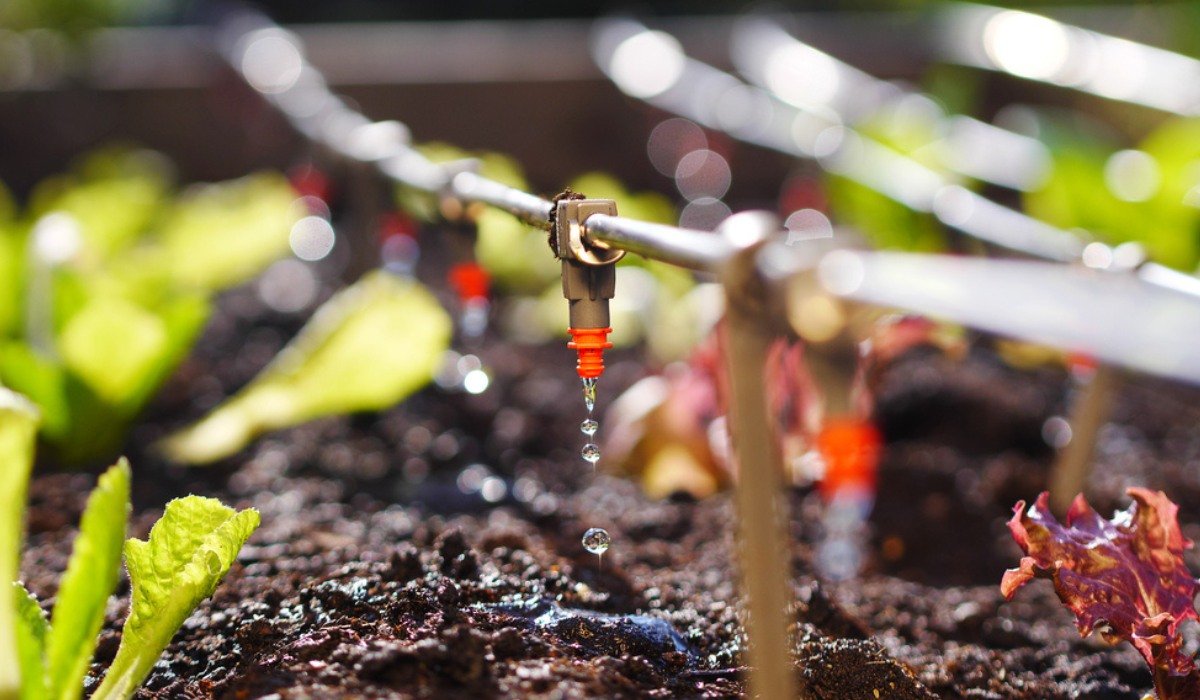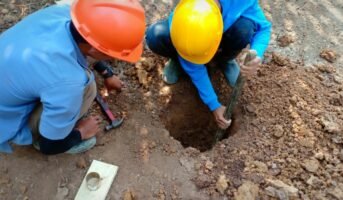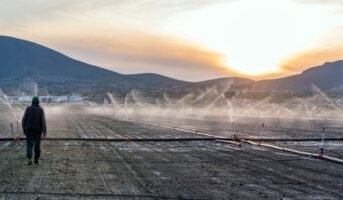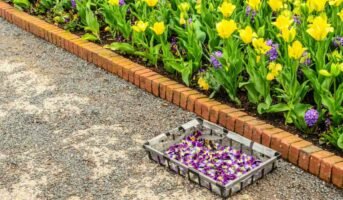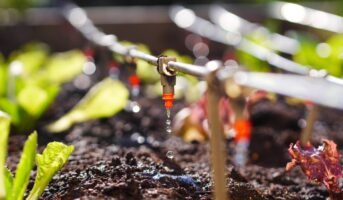Millions of farmers worldwide are experiencing life-changing changes because of the drip irrigation system, which allows higher yields to be produced from any soil while utilising less water, fertiliser, and energy. When using a system of small-diameter plastic pipes fitted with outlets known as emitters or drippers, the drip system, often called trickle irrigation, drips water onto the soil at meagre rates (two to 20 litres/hour).
Instead of saturating the entire soil profile as with surface and sprinkler irrigation, water is supplied near the plants so that just the area of soil where the roots develop is moist. The drip system demands more frequent watering than other methods (usually every one to three days), resulting in excellent high moisture content in the soil where plants thrive.
The drip irrigation system irrigates the crop by dispersing emission points along a network of mainlines, sub-mains, and lateral lines. Each dripper or emitter distributes water, nutrients, and other vital growth components into the plant’s root zone in a calibrated, precisely controlled, and uniform manner.
The emitters release water and nutrients into the soil, which are then carried by capillary action and gravity into the root zone of the plants. By doing this, the plant’s extraction of moisture and nutrients is nearly immediately restored, ensuring that it never experiences water stress and improving quality, high yield, and optimum growth.
known about: Capsicum Plant
How does it work?
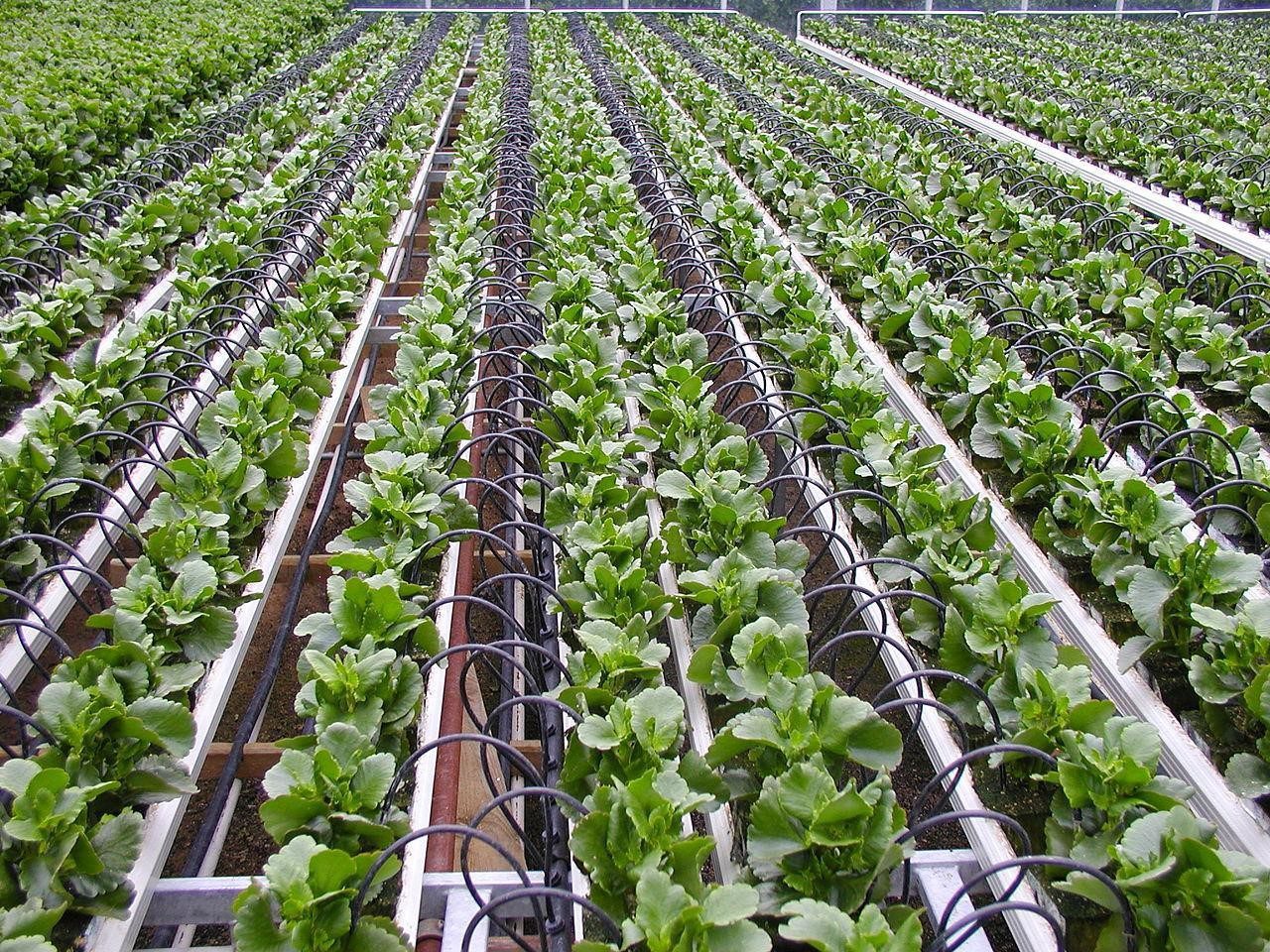
Source: Wikimedia
Dripper lines of smaller components called “drippers” transport water and nutrients across the field. To evenly distribute water and nutrients to each plant’s root zone across the area, each dripper releases drips carrying water and fertilisers.
Major parts of a drip irrigation system
Water delivery system
A water delivery channel constructed of either polyethylene tubing for above-ground delivery or PVC pipe for underground delivery makes up most all drip irrigation systems. The water delivery system consists of several components that use a network of mainlines, pipelines, and drip lines joined by couplings to transport water from the water supply to the plants.
Water filters
Water filters are a crucial component of every system because they keep silt and other particles out of the system, allowing you to provide clean water to your plants. In-line filters of many kinds, including media, screen, and disc filters, as well as sand separators, are sold by drip system providers to match a variety of installations. Each is made to be used with specific types of water.
Water pressure control devices
Each system has water pressure regulators to ensure water reaches every area of your irrigation supply. In addition, companies that sell drip irrigation system supplies sell fixed outlets and adjustable outlet pressure regulators to address high- and low-pressure issues that may reduce watering effectiveness. The proper pressure regulators are essential to ensure uniform application and prevent feed pipes and tubing damage due to over-pressurisation.
Valves and gauges
Various valves and gauges are utilised with drip irrigation systems, particularly ones intended to water numerous areas from a single water source. Water flow control devices include manual and automatic gates, ball, solenoid, and anti-siphon valves. In addition, water flow through various parts of the line is measured by water meter gauges.
Injectors for chemicals
The ability of drip irrigation system services to transport fertilisers, insecticides, and anti-clogging agents to the drip nozzles and water to the plants is a remarkable feature of the watering systems they sell. To mix with the water running through the lines and to the plants, chemical injector devices are installed and send these chemicals into the water feed at a predetermined rate.
System manager
The programmable controller, which controls how long the water stays in the delivery lines and on the fields, is the final component of any drip system offered by a supplier of drip systems. These can be found in manually programmed types that only turn on and off when instructed. Additionally, computer models can recognise the state of the soil and switch it on and off as needed to water plants effectively.
Wetting pattern in drip irrigation
Instead of surface and spray watering, drip irrigation only wets a section of the soil’s root zone. As a result, it could only moisten 30% of the soil compared to the other approaches. Depending on discharge and soil type, wetting patterns that result from water dripping onto the ground might form.
Even when only a portion of the root zone is moist, it is still crucial to supply the crop with all the water it requires. Some people believe drip irrigation helps the environment by lowering the water needed by the crop. That is untrue. How water is applied does not affect how much is used for crops. Just the appropriate amount is necessary for crops to grow well.
A drip irrigation system can reduce deep percolation, surface runoff, and soil evaporation, resulting in water savings. However, it is important to remember that savings are as much a result of the user as they are of the machinery.
A drip system is not a suitable replacement for other tested irrigation techniques. Just another method to apply water. It works best in regions with low water quality, sloped or undulating, poor-quality soil, high costs for labour or water, or regular watering requirements for high-value crops.
Crops suitable for drip irrigation system
| Orchard crops | Grapes, Banana, Pomegranate, Orange, Citrus, Mango, Lemon, Custard Apple, Sapota, Guava, Pineapple, Coconut, Cashew-nut, Papaya, Aonla, Litchi, Watermelon, Muskmelon, etc. |
| Vegetables | Tomato, Chilly, Cauliflower, Cabbage, Capsicum, Onion, Okra, Brinjal, Ridge Gourd, Cucumber, Peas, Spinach, Pumpkin, etc. |
| Cash crops | Sugarcane, Cotton. Arecanut, Strawberry, etc. |
| Flowers | Rose, Carnation, Gerbera, Anthurium, Orchids, Jasmine, Dahilia, Marigold, etc. |
| Plantation | Tea, Rubber, Coffee, Coconut, etc. |
| Spices | Turmeric, Cloves, Mint, etc. |
| Oil seed | Sunflower, Oil palm, Groundnut, etc. |
| Forest crops | Teakwood, Bamboo, etc. |
Response of crops to drip irrigation system
| Crops | Water saving (%) | Increase in yield (%) |
| Banana | 45 | 52 |
| Cauliflower | 68 | 70 |
| Chilly | 68 | 28 |
| Cucumber | 56 | 48 |
| Grapes | 48 | 23 |
| Ground nut | 40 | 152 |
| Pomegranate | 45 | 45 |
| Sugarcane | 50 | 99 |
| Sweet lime | 61 | 50 |
| Tomato | 42 | 60 |
| Watermelon | 66 | 19 |
Why do farmers and plants prefer drip irrigation?
Farmers
In addition to providing a higher return on investment (ROI) than other irrigation techniques, the drip irrigation system offers farmers an efficient way to manage their fields.
- Higher, more reliable yields of quality
- Significant water savings because there is no evaporation, runoff, or waste
- Drip irrigation uses all available areas to their fullest potential regardless of topography or soil type.
- Energy savings: drip irrigation operates under low pressure; effective fertiliser use; no leaching;
- Less reliance on the weather, more consistency, and reduced dangers
Plants
Like people, plants prefer to receive their nutrients and water in a balanced manner. The same is true for plants; nobody wants to consume a month’s worth of food in a single sitting. Therefore, drip irrigation frequently and sparingly supplies water and nutrients to ensure the best growing conditions and the enormous yields possible.
Why drip irrigation makes plants more productive?
- Plenty of water and nutrients are available
- Customised water and fertiliser dosages for the demands of the plant
- Good soil aeration and absence of saturation
- Prevents high salinity brought by overfertilising
- No wetness of the foliage can cause fungi to spread
Drip irrigation importance: Why the world needs drip irrigation?
There will be ten billion people on earth by 2050, and each person will need 20% less arable land to provide enough food. Given the growing water shortage, you need a technique to boost agricultural output and resource efficiency. The drip system can help with that by enabling farmers to generate more calories per hectare and cubic meter of water, which alters the economics of global agriculture.
- Lessen the adverse effects of drought and climate change on food production
- Avoid letting fertiliser leaching contaminate rivers and groundwater
- Support rural communities, fight poverty, and stop people from moving to cities
see: All about Furrow Irrigation
Water conservation through drip irrigation system
Following are some methods for conserving water:
- Application consistency for drip irrigation is relatively high—generally over 90%.
- Drip irrigation, instead of sprinklers, irrigates the soil directly, preventing water loss due to wind.
- Water can be fed to the crop or plant root zone exactly in the quantities needed because application rates are modest. Other techniques demand more water to be applied and less frequently. When young plants require frequent irrigation, a large portion of the water is commonly lost mostly due to runoff or deep percolation.
- Low application rates may not cause washing away on sloping terrain or heavy soils.
- Non-targeted areas such as roads and furrows in agriculture, the spaces between benches, blocks, and beds in greenhouses, and hardscapes like buildings and roads are not watered by drip irrigation.
- Sprinklers and gravity irrigation cannot effectively water irregularly shaped planting areas, but drip irrigation can.
- The ability of drip irrigation to germinate seeds and establish transplants avoids the need for sprinkle ring-up and the waste that results during the initial phases of crop growth.
See also: Water conservation projects and methods adopted in India: Tips to conserve water at home
Uses of drip irrigation
The drip irrigation system is employed in farms, industrial greenhouses, and private gardens. In locations with extreme water scarcity, drip irrigation is used, particularly for crops and trees, including coconuts, containerised landscape trees, bananas, eggplant, citrus, sugarcane, grapes, strawberries, maize, cotton, and tomatoes. Homeowners are becoming increasingly interested in drip irrigation kits, which include a timer, tubing, and emitter. Irrigating flower pots require hoses with a diameter of 4 mm (0.16 in).
Drip irrigation advantages
- A localised application and lessened leaching help to prevent fertiliser and nutrient loss.
- If handled properly, water application efficiency is excellent.
- Field grading is not required.
- Fields with asymmetrical shapes can be accommodated with ease.
- You can utilise recycled, non-potable water without risk.
- The root zone’s moisture content can be kept at a field-capable level.
- The frequency of irrigation is less affected by soil type.
- The erosion of the soil is reduced.
- The growth of weeds is slowed.
- The output of each nozzle manages highly consistent water distribution.
- Compared to alternative irrigation technologies, labour costs are lower.
- The valves and drippers can be adjusted to control supply variation.
- Fertigation can be added with little fertiliser waste.
- The risk of disease is lower because the foliage is still dry.
- Reduced energy costs because it is often operated at a lower pressure than other pressure irrigation methods.
Drip irrigation disadvantages
- Initial expenses may exceed those of overhead systems.
- The lifespan of drip irrigation tubes may be shortened by exposure to the sun. The dangers of plastic degradation to the soil and food crops. The estrogenic compounds, which would keep the plastic flexible, have been released into the environment as the sun dissolves many types of plastic, leading it to become brittle.
- Clogging or biologging may occur if the equipment is not adequately maintained and the water is not filtered correctly.
- The irrigator cannot see the water applied with a subsurface drip. It can cause the farmer to use too much or insufficient water; individuals new to drip irrigation are especially likely to experience this.
- If pesticides or top-dressed fertilisers require sprinkler watering to activate them, drip irrigation may not be sufficient.
- After harvest, drip tape results in more expenses for cleanup. In addition, users must prepare for drip tape winding, disposal, recycling, and reuse.
- Inadequate installation might result in a waste of time, water, and harvest. These systems necessitate a thorough examination of all pertinent variables. It is like the land’s topography, soil, water, crop, and agro-climatic conditions, and the compatibility of the drip irrigation system and its parts.
- Subsurface drip may not be able to moisten the soil’s surface sufficiently for germination in lighter soils.
- It requires giving the installation depth and serious thought.
- Most drip systems have little or no leaching fraction since they are high-efficiency. Salts added to irrigation water without sufficient leaching may accumulate in the root zone, typically near the periphery of the wetting pattern. Drip irrigation, on the other hand, stays away from the typical surface-applied irrigation’s high capillary potential, which has the potential to draw salt deposits up from below.
- The PVC pipes frequently experience rodent damage, necessitating tube replacement and raising costs.
- Night frost damage management cannot be accomplished with drip irrigation systems.
In conclusion, plants can be watered more effectively using drip irrigation and are protected from sprinklers’ strong sprays. Additionally, it aids in distributing water to plants more uniformly, ensuring that each one has a similar aesthetic appeal to the others.
FAQs
Which plants can benefit from drip irrigation?
Drip irrigation can be used to grow any crop, from vegetables and tree crops to field crops like maize, soybeans, or sugarcane. They grow in soil or a medium without dirt, and drip irrigation works on all topographies, whether a level field or a sloping landscape. So the only choice is picking the proper drip setup based on your crop and the area's state.
Does drip irrigation work well?
With a water consumption efficiency of 95–100%, drip irrigation is recognised to be the most effective irrigation technique. It is in contrast to flood and furrow systems, which are 60–70% efficient, or sprinkler systems, which use 80–85% less water. Efficiency is related to how well the system performs concerning the crop, yield, and the farmer's profitability.
Does drip irrigation cost a lot?
Farmers should compare their ROI with other watering options before investing in a drip irrigation system. Drip irrigation can pay for itself relatively quickly and boost farmers' profits since it produces significant crop yields using fewer inputs (water, fertiliser, energy, and labour).
Why is drip irrigation the best method?
Housing News Desk is the news desk of leading online real estate portal, Housing.com. Housing News Desk focuses on a variety of topics such as real estate laws, taxes, current news, property trends, home loans, rentals, décor, green homes, home improvement, etc. The main objective of the news desk, is to cover the real estate sector from the perspective of providing information that is useful to the end-user.
Facebook: https://www.facebook.com/housing.com/
Twitter: https://twitter.com/Housing
Email: [email protected]
